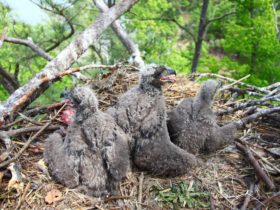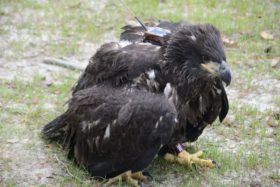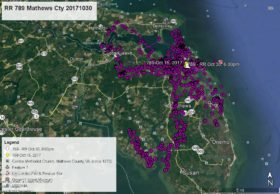Azalea Remains in Poquoson, VA 8/28
Camellia at Carolanne Farms 8/28
August 29, 2012KE at King George County Landfill 8/30
August 31, 2012Azalea spent a couple days checking out Grandview Beach and Nature Preserve in Hampton (she has been there before), but has returned to Poquoson and the marshes on the east side of town. But being an urban eagle, she just can’t stay away from places where people work and live. Here are her data points – YELLOW arrow Aug 25 at 1:00am, PINK pointer Aug 26 at 7:00am, GREEN pointer Aug 27 at 1:00am, PURPLE pointer Aug 28 at 1:00am, and as of this satellite map WHITE arrow Aug 28 at 1:00pm.






7 Comments
Thanks, Reese.
Thanks for the up date..I check every day..I bet she was one soggy eagle with all the rain they got
Thanks for the update, always enjoy hearing about our eagles!
Thanks Reese, good to see her away from THAT place in NC!
I’m kind of curious. You here refer to Azelea as an urban eagle and I have seen this term used many times before to refer to her, to Camellia, to the NBG eagles, and others. I understand the concept and suppose that biological adaptation is at the root. But what I am curious about is why certain eagles do adapt to urban circumstances and why others are, what, rural eagles I suppose. Is it socialization? Is it particular types of foods? Is it particular means they have to use to procure their foods? Is it particular kinds of places they like to hang out? Is it even just they are okay with people and all that we bring to a landscape? In which case why do they seem to seek that out rather than just accept it in certain circumstances? As an anthropologist (specifically archaeology) I certainly can see why people exhibit these preferences, but I am interested in how eagles might develop same.
Response – Thanks for your question re “urban” eagles. What we are beginning to observe is a significant change in the habituation of some bald eagles to our human activities, sounds, and places we occupy. During the DDT era in North America many species were in dramatic decline including bald eagles. Subsequent to the ban of persistent pesticides like DDT the population of bald eagles has recovered. However, the population of humans in the United States has doubled from about 150 million to 350 million during the same period. So has the land that we occupy with our homes, business complexes and shopping centers. Eagles are now finding it more difficult to locate the remote nesting sites they have previously occupied because such land is more scarce, and the competition among eagles has also increased. A small percent of bald eagles, currently about 5% in Virginia, have begun to establish their territories in human occupied locations – golf courses, gardens like Norfolk Botanical Garden, and private residential property. The young eagles being raised in these “urban” nests are little affected by our human activities, and both Azalea and Camellia have shown us that is true with their travels by occasionally spending a week or more at a time in residential subdivisions. I fully expect we will see more and more “urban” bald eagles in future years. The bald eagles wearing purple leg bands, which CCB began using in 2007, will provide the opportunity for us to identify those bald eagles that establish “urban” nests. Perhaps in the years to come, satellite transmitter average life will exceed 3 years which will provide even more opportunity to observe more of the life span of eagles and other species.
Great questions dcr. Thanks for the detailed explanation Reese!
Reese, thanks so much for the detailed response to my questions.